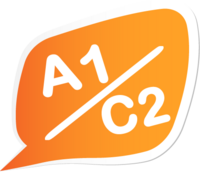TestAS Prüfung in Heidelberg
Der TestAS ist ein freiwilliger, standardisierter Test für Abiturienten aus Ländern außerhalb der Europäischen Union, die eine universitäre Laufbahn an einer Hochschule in Deutschland einschlagen wollen. Die Prüfung wird von ITB Consulting GmbH entwickelt und von der Gesellschaft für Akademische Studienvorbereitung und Testentwicklung e. V. angeboten.
Die TestAS Prüfung misst die Studierfähigkeit, deshalb gleicht sie in weiten Teilen im Aufbau einem Intelligenztest und überprüft kognitive und intellektuelle Fähigkeiten. Das gibt Auskunft über die akademische Eignung eines Schülers. Den TestAS kann man an sechs zentral festgelegten Terminen ablegen. Die Academy of Languages Heidelberg ist als Testzentrum für TestAS zugelassen und führt diese Prüfung seit Jahren regelmäßig durch.

dein Highlight
✓ regelmäßige Termine
✓ langjährige Erfahrung

individuelle Vorbereitungskurse
✓ bessere Ergebnisse dank zielgerichteter Vorbereitungskurse
Warum sollte man den TestAS machen
Mit guten Testergebnissen können Sie Ihre Chancen auf einen Studienplatz an einer Hochschule in Deutschland verbessern. Die Prüfung kann an unserem Prüfungszentrum auf Deutsch oder Englisch abgelegt werden.
Die Prüfungsergebnisse informieren jeden Teilnehmer über seine individuellen Stärken und Schwächen und geben den wahrscheinlichen Erfolg in einem Studienfeld an. Dies sind wertvolle Informationen für Schüler, da sie ihnen helfen die Studienrichtungen zu finden, die zu ihren individuellen Fähigkeiten passen.
Deshalb kann ein gutes Testergebnis die Chancen des Bewerbers auf eine Zulassung an der gewünschten Hochschule und für den gewünschten Studiengang erhöhen. Die Ergebnisse erhöhen außerdem die Wahrscheinlichkeit, dass ein Studierender das gewählte Studienprogramm abschließt und nicht aufgrund fehlender Kompetenzen vorzeitig abbricht.
Wichtige Fragen und Antworten zu TestAS
Wie melde ich mich zur TestAS Prüfung an und was kostet sie?
Der TestAS wird an einer begrenzten Anzahl an Terminen pro Jahr durchgeführt.
Wir bieten eine unkomplizierte Anmeldung in unserem Testzentrum an:
Sie nehmen eine verbindliche Anmeldung über unser Online Formular oder persönlich vor Ort vor. Die Gebühren sind sofort fällig. Nach Begleichung der Prüfungsgebühren erhalten Sie von per E-Mail eine TAN (Transaktionsnummer), die Sie noch innerhalb der Anmeldezeitraumes während des Anmeldeprozesses auf www.testas.de einlösen müssen, um endgültig für die Prüfung angemeldet zu sein.
Bitte überprüfen Sie rechtzeitig, ob Sie eine TAN erhalten haben. Überprüfen Sie auch Ihr SPAM Postfach oder Junk Mail Ordner Ihres Mail Providers.
Welche Sprache ist für mich die richtige?
Sie sollten den TestAS in der Sprache absolvieren, in der Sie sich sicher fühlen. Falls nun Ihre Englischkenntnisse Ihre Deutschkenntnisse übertreffen, dann ist es ratsam den TestAS auf Englisch zu wählen. Denn die Sprachkenntnisse haben einen direkten Einfluss auf das Ergebnis.
Gleichwohl werden Teilnehmende mit einem B1 Niveau zur Prüfung zugelassen. Dies reicht aus um einige Teilaufgaben zu lösen und Diagramme zu interpretieren. Viele Abschnitte der Prüfung umfassen anspruchsvolle Texte, die das Leseverständnis und die Fähigkeit Zusammenhänge zu erkennen, testen. Daher gilt umso höher das sprachliche Niveau, umso besser das Prüfungsergebnis.
Was muss ich am Prüfungstag unbedingt mitbringen?
Einen amtlichen, gültigen Lichtbildausweis. Es muss derselbe Ausweis sein, den Sie bei der Registrierung im TestAS Portal angegeben haben.
Die Zulassung zur Prüfung mit der Teilnehmernummer. Die sollte von Ihnen im TestAS Portal heruntergeladen und ausgedruckt werden.
Mehrere Kugelschreiber für den Kerntest und die fachspezifischen Module.
Studierende müssen ihre eigenen Kugelschreiber mitbringen. Alle anderen Hilfsmittel, einschließlich Taschenrechner, Wörterbücher, Mobiltelefone, oder Ähnliches sind streng verboten und können bei Nichtbeachtung den Ausschluss aus der Prüfung als Konsequenz haben.
So läuft der TestAS ab:
Der TestAS besteht aus:
Der TestAS beginnt mit dem Kerntest. Dieser Abschnitt dauert 110 Minuten und beurteilt die Fähigkeiten, die für ein erfolgreiches Studium in allen universitären Fächern notwendig sind und ist in vier weitere zeitlich begrenzte Subtests aufgeteilt.
- Teil 1 "Quantitative Probleme lösen" (45 Minuten): Kurze Textaufgaben mit einfachen Berechnungen und mathematischer Argumentation lösen.
- Teil 2 "Beziehungen erschließen" (10 Minuten): Erkennen von Verbindungen zwischen zwei Wortpaaren.
- Teil 3 "Muster ergänzen" (20 Minuten): Dieser Teil wird gemeinhin als der anspruchvollste des Kerntests betrachtet. In diesem Subtest geht es darum Muster in geometrischen Figuren zu erkennen und diese logisch fortzuführen.
- Teil 4 "Zahlenreihen fortsetzen" (25 Minuten): Frühere Teilnehmende empfinden diese Teilaufgabe als unkompliziert. Es geht hier darum Zahlenfolgen sinnvoll fortzuführen. Dies testet die Fähigkeit, Zahlenfolgen fortzusetzen. Studierende berichten, dass dieser Teil unkompliziert sei. Im Teil unseres Buches, der Zahlenreihen erläutert, findest du Informationen, die dir bei einigen häufig vorkommenden schwierigen Zusammenhängen helfen.
Nach eine Pause von 30 Minuten folgen die Fachspezifische Module. Dafür haben Sie 145-150 Minuten Zeit. Sie erhalten die Aufgaben, die mit Ihrer gewählten Studienrichtung korrespondieren.
Zur Auswahl stehen:
- Geistes-, Kultur- und Sozialwissenschaften
- Ingenieurwesen
- Mathematik, Informatik und Naturwissenschaften
- Wirtschaft
a) Geistes-, Kultur- und Sozialwissenschaften (150 Minuten – 3-teilig)
- Teil 1 "Texte verstehen und interpretieren " : In diesem Subtest sind gute Sprachkenntnisse das A und O, denn es geht um Textverständnis und sinnvolle Schlussfolgerungen.
- Teil 2 "Repräsentationssysteme flexibel nutzen" misst induktive Argumentationsfähigkeiten. Diese Aufgabe verlangt eine schnelle Auffassungsgabe von Text und Diagramm, denn daraus muss in Bezug zur Fragestellung eine allgemeine Schlussfolgerung gezogen werden.
- Teil 3 "Sprachstrukturen erkennen" misst die Fähigkeit, Sprachmuster und semantische Beziehungen zu erkennen.
b) Ingenieurwesen (150 Minuten – 3-teilig)
Diese Prüfung misst die Fähigkeit, aus abstrakten Konzepten zu folgern und von wissenschaftlichen und technischen Fakten zu abstrahieren. Sie ist in drei Teile unterteilt:
- Teil 1 "Technische Sachverhalte formalisieren": Sie sollen hier beschriebene technische oder wissenschaftliche Fakten in eine formelhafte Darstellung transferieren.
- Teil 2 "Ansichten erschließen": In diesem Subtest ist Ihr räumliches Vorstellungsvermögen gefordert.
- Teil 3 "Technische Zusammenhänge analysieren": Die Fragen stammen aus der Physik, Astronomie, Chemie und den Geowissenschaften und sind in der Regel so formuliert, dass der Teilnehmende mit einem allgemeinen Verständnis der wichtigsten Naturkonzepte die Fragen beantworten kann.
c) Mathematik, Informatik und Naturwissenschaften (145 Minuten - 2-teilig)
- Teil 1 "Naturwissenschaftliche Sachverhalte analysieren": Die Fragen umfassen die Gebiete Astronomie, Geographie, Botanik. Es schadet nichts, sich die Schulbücher aus den MINT Fächern zur Vorbereitung noch einmal zu studieren.
- Teil 2 "Formale Darstellungen verstehen": Bei diesem Subtest kommt es wieder auf Ihr Sprachniveau an. Denn es ist wichtig, dass Sie die Problemstellung in der Frage richtig verstehen. Dieser Teil ist der anspruchsvollste in diesem Fachmodul und macht die Hälfte Ihrer Note in diesem Modul aus.
d) Wirtschaftswissenschaften (150 Minuten – 2-teilig)
- Teil 1 "Wirtschaftliche Zusammenhänge analysieren": Karten, Diagramme und Tabellen kommen aus dem Themenbereich Wirtschaft und müssen analysiert und logisch geschlussfolgert werden.
- Teil 2 "Prozesse analysieren": In diesem Substest werden Ihr kritisches und analytisches Denkvermögen auf den Prüfstand gestellt. Hier ist ein hohes Sprachniveau hilfreich, um die Problemstellung in der Frage zu erfassen und zu lösen. Dieser Abschnitt macht die Hälfte Ihrer Note in diesem Subtest aus.
Nach der Prüfung: Wie bekomme ich mein Zertifikat?
Die Ergebnisse der TestAS Prüfung sind ca. vier Wochen nach der Prüfung online über das individuelle Teilnehmerportal verfügbar. Um Ihr Ergebnis zu sehen und herunterzuladen, benötigen Sie Ihren selbstgewählten Benutzernamen und Ihr Passwort.
Die Testergebnisse sind ausschließlich Ihnen zugänglich. Sie werden erst sichtbar für eine Hochschule, wenn Sie Ihre Ergebnisse Ihren Bewerbungsunterlagen beifügen.
Das TestAS Zertifikat enthält eine Notenliste für jeden Testabschnitt und ist unbegrenzt gültig.
Expertentipps für Prüflinge
Der Kerntest sowie die fachspezifischen Module sind schriftliche Multiple-Choice-Tests. Stellen Sie in der Prüfung sicher, dass Sie alle Antworten auf dem Antwortbogen festhalten. Ist eine Teilaufgabe abgeschlossen ist es unmöglich zu einem späteren Zeitpunkt darauf zurückzukommen.
Stichwort Zeitmanagement: Die Fragen sind mit aufsteigendem Schwierigkeitsgrad angelegt. Es ist also ratsam die ersten Fragen zügig zu beantworten, damit man für die Schlussfragen genug Zeit übrig hat.
Bitte beantworten Sie alle Fragen. Falsch beantwortete Fragen werden nicht sanktioniert. Unbeantwortete Fragen bringen einen Punktabzug.
Der TestAS dauert insgesamt über 4 Stunden.
Schlafen Sie in der Nacht davor ausreichend und bringen Sie zum Prüfungstag genügend Getränke, Snacks und Traubenzucker mit, um Ihr Energieniveau während der Prüfung zu halten.
Fragen und Anmeldung zu TestAS
Die Anmeldung zu den Prüfungsterminen für den TestAS an der Academy of Languages erfolgt ausschließlich über das Portal des Prüfungsanbieters g.a.s.t..
Der TestAS muss kein Angstgegner werden! Wir helfen Ihnen mit unseren prüfungsvorbereitenden Kursen diese anspruchsvolle Prüfung mit den gewünschten Ergebnissen zu bestehen. Unsere qualifizierten Lehrkräfte unterstützen Sie dabei Ihre Kompetenzen zu schärfen und so mit der besten Vorbereitung in den TestAS zu gehen.

"Gerne berät Sie unser Team aus dem Prüfungszentrum zur Wahl der passenden Prüfung!"
[Tina Gajdics, Beraterin der Academy of Languages]
